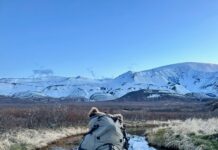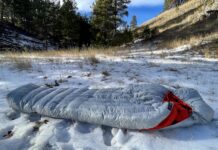A high-quality tent is a vital part of the backcountry hunter’s sleep system. It can very easily make or break a hunt if you encounter weather like so many of us do on our adventures. After years of running floorless shelters with and without a stove, 1-person and 2-person free-standing tents, and even 4-season tents, I have found that they all have their place for different hunts. I eyed the Nemo Hornet Elite Osmo 1P as fitting the bill for early season run & gun type of hunts. It’s lightweight, small and compact, and well-built if I were to encounter a gnarly early-season storm. It’s the perfect balance between weight, toughness, and livability, making it stand out in a crowded market of single-person tents. While on the higher end of the price spectrum, its features and durability justify the cost for serious hunters.

NEMO Hornet Elite Osmo 1P Tent
Right out of the box, it’s incredibly user-friendly to set up. In under three minutes, I had it set up and staked out, ready for my pad and quilt. The floor has some rigidity in the corners, giving it a bathtub feel which is piece of mind should you get some heavy rain. Storage pockets are well thought out with the placement. The pockets are within reach when laying down or sitting up, right where you think they should be.
A patent pending “Flybar” is built into the pole system and gives you some added volume up near the top of the tent, a nice touch when sitting up. The vestibule is extremely spacious and provides ample room for your pack, boots, and weapon.
At the end of the day, this is still a 1-person tent, and there is not much room inside the tent for anything other than yourself and some clothes and food. For a height limit reference, I’m 5’ 11” and had a little room to spare but not much. I’d say 6’ 2” would be the limit.
The tent packs into a stuff sack called the Divvy Cube (rectangle-shaped) and really nests in your pack well, taking up minimal space.
See it here at Black Ovis.

Tent Material
With the floor and rainfly being made from OD Osmo Ripstop and the tent body being Osmo (Osmo is a proprietary fabric that is a poly-nylon composite fabric), the tent has an incredibly robust feeling to it for being under two pounds. In the past, light tents typically felt like you could tear through them with a dull stick, but not the Hornet built with Osmo.
Rain and Wind
Over the course of this summer and early fall, we were blessed with great weather, which is not always the best for testing gear, but I will take what I was dealt. The tent handled moderate wind (10-12 mph) without issue, and I am confident it would handle anything you’re willing to ride out.
The rain fly is seam-sealed and offers excellent water repellency (hose tested). All the guy-out lines are reflective string, and the tensioners work great and really bite for being so small. The rainfly stops at the perfect height on the body of the tent, giving it great airflow and cutting down on the condensation.

Tent Stakes
The tent comes with six stakes, which is exactly how many you need. That is great, however, with the design of the stake, the hook in one of the ribs to catch the guy line, creates a weak point as I discovered. I was using a rock that was too big and it didn’t stand a chance. This is not a major issue, but it’s something to consider, so be sure to put an extra stake or two in the bag. So far, I am very pleased with the Hornet Elite Osmo and it has a spot in my shelter arsenal for years to come. Available here.

Comment or ask Brock questions here.
*Black Ovis, a Rokslide sponsor, provided this tent for review. The author is free to give positive or negative feedback.




















